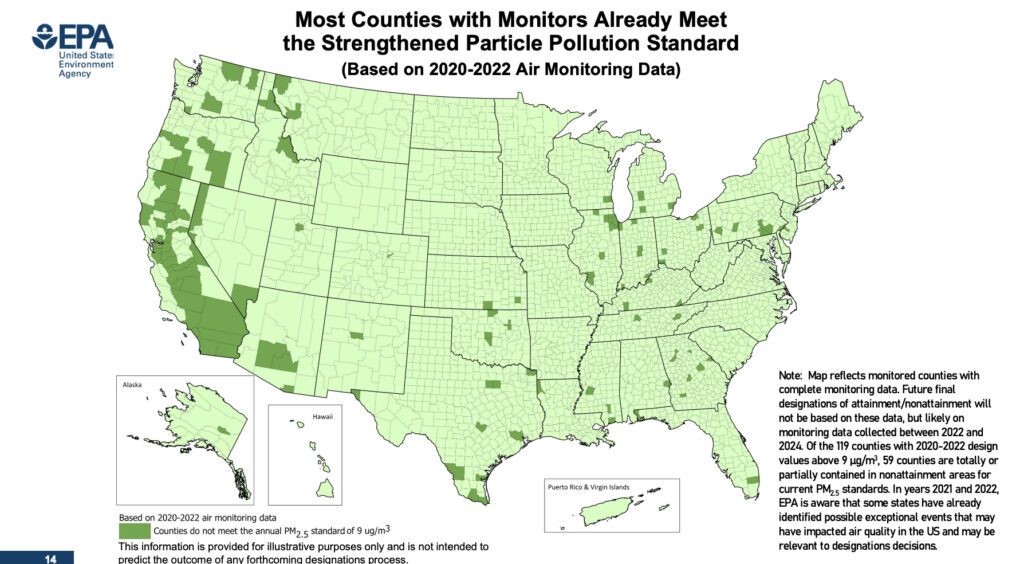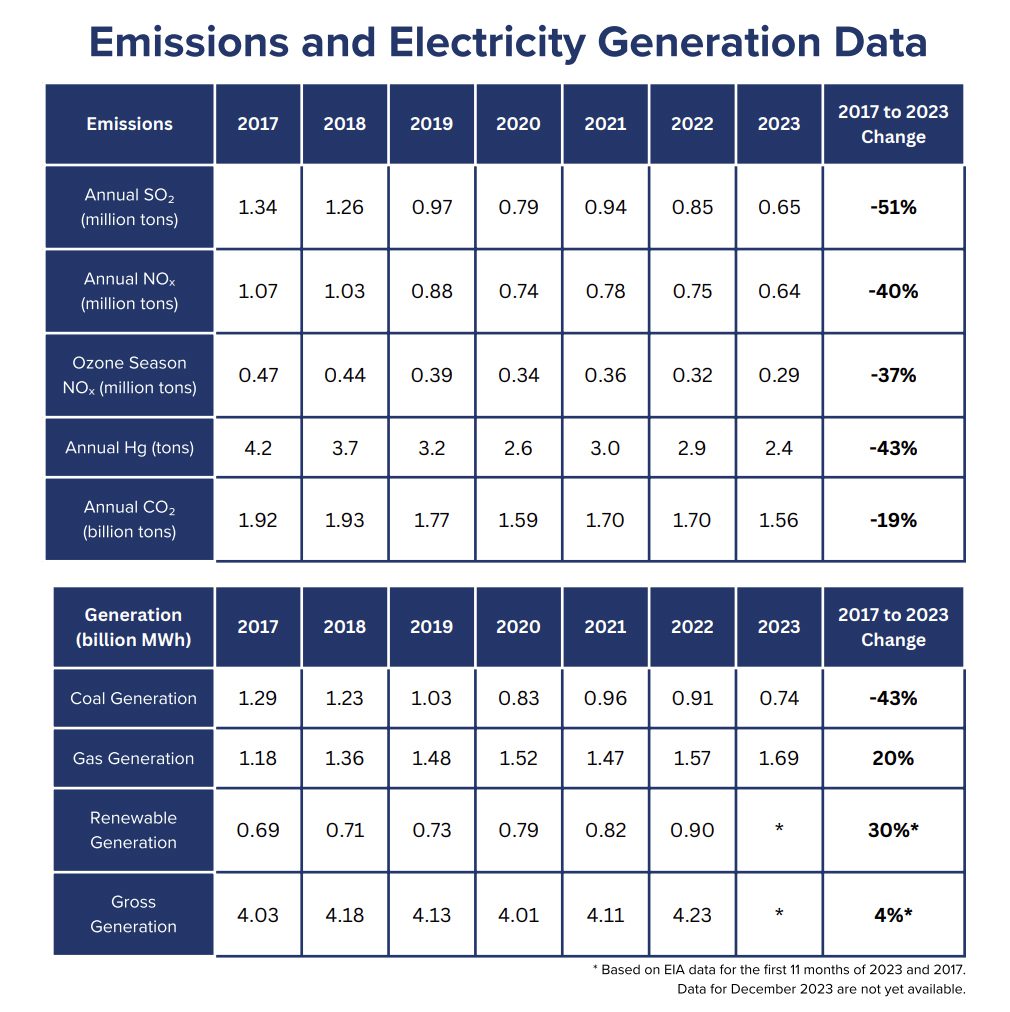EPA Rolls Out Final, More Stringent PM2.5 Standard
The U.S. Environmental Protection Agency (EPA) in February issued a final rule imposing tighter restrictions on fine particulate matter (PM2.5) or soot.
The final rule, issued on Feb. 7, strengthens the nation’s National Ambient Air Quality Standards (NAAQS) by lowering the level of the primary (health-based) annual PM2.5 standard from 12.0 micrograms per cubic meter (µg/m3) to 9.0 µg/m3. The EPA, however, retained the primary 24-hour PM2.5 standard at its current level of 35 µg/m3 and the primary 24-hour PM10 (coarse particle) standard at its current level of 150 µg/m3. It also concluded secondary PM standards—standards to protect public welfare—provide a sufficient safeguard, and it determined no changes were necessary “at this time.”
A Tighter Rule for Regional Impact
“This final rule does not make any air quality attainment/nonattainment designations,” the EPA noted. “Consistent with Clean Air Act timelines, EPA is required to designate areas as attainment or nonattainment within 2 years of the final rule.” However, most counties with monitors already meet the strengthened PM2.5 standard, it said. In 2032, only around 52 counties—23 in California—would not meet the new standard, the agency estimated.

Areas with air quality that do not meet the new standard will be designated by the EPA, likely in 2026, as “nonattainment.” That will trigger an obligation for states to revise their state implementation plans (SIPs) to obtain further emission reductions to ensure that the new standard will be met. States are expected to submit SIP revisions within three years after a final NAAQS.
The power industry suggests areas around some generating facilities may be deemed nonattainment, which could subject them to additional pollution controls or operational constraints. However, because SIP revisions by affected states will take time to complete, it is unclear how SIP requirements will affect regional power generation.
‘New Science on Harms’
The agency said it promulgated the final rule “to reflect new science on harms caused by particle pollution.” The rule takes into consideration “the available scientific evidence, advice from the Clean Air Scientific Advisory Committee (CASAC), and nearly 700,000 public comments.” The stronger PM NAAQS “will advance environmental justice by leading to reductions in particle pollution, which disproportionately burdens communities of color and other vulnerable communities,” it said.
By law, the EPA cannot consider costs in setting or revising NAAQS. “However, to inform the public, EPA analyzes the benefits and costs of implementing the standards as required by Executive Orders 14094, 12866 and 13563 and guidance from the White House Office of Management and Budget,” the agency noted. The EPA’s Regulatory Impact Analysis suggests estimated costs associated with control strategies for the revised standards will amount to $594 million in 2032 (2017$, 7% interest rate). Its estimated monetized benefits associated with these control strategies are approximately $20 billion and $42 billion in 2032 (2017$, based on a real discount rate of 7%).
Falling Power Sector Air Pollutant Emissions
The Clean Air Act (CAA) requires the EPA to set two types of NAAQS for PM: primary standards to protect public health “with an adequate margin of safety,” and secondary standards to protect public welfare from both known and anticipated adverse effects, including from haze in cities and national parks. Under the law, the EPA must review the NAAQS every five years to determine whether they should be retained or revised.
Since 1971, the agency has now regulated PM pollution four times—in 1987, 1997, 2006, 2012, and 2024. In 2012, the Obama administration tightened the primary standard for PM2.5 to 12.0 micrograms per cubic meter (µg/m3) from the existing 1997-set annual standard of 15.0 μg/m3, but it retained the 2006-issued 24-hour primary fine particle standard of 35 μg/m3. The Trump administration in 2020 retained its existing NAAQS for both fine and coarse PM (PM2.5 and PM10).
Fine particles (PM2.5), which are 2.5 micrometers in diameter and smaller, are emitted by a variety of sources, including smokestacks, vehicles, and fires, but they also form when gases emitted by power plants, other industrial processes, and gasoline and diesel engines react in the atmosphere. PM2.5 precursor gases include sulfur dioxide (SO2), nitrogen oxides (NOX), volatile organic compounds, and ammonia.
Coarse particles (PM10), which have diameters between 2.5 and 10 micrometers, include road dust kicked up by traffic, some agricultural operations, construction and demolition operations, industrial processes, and biomass combustion.
According to the EPA, PM2.5 concentrations have largely decreased, corresponding to reductions in SO2 emissions from large power plants in the Eastern U.S. and NOX reductions from mobile sources and power plants.
The EPA noted its rule considered several other regulations. These include the final Good Neighbor Plan for the 2015 Ozone NAAQS (2023), the revised Cross-State Air Pollution Rule Update (2021), Standards of Performance for Greenhouse Gas Emissions from New, Modified, and Reconstructed Stationary Sources (2015), the Mercury and Air Toxics Rule (2011), and provisions of tax incentives in the Inflation Reduction Act of 2022 (IRA).

On Feb. 15, the EPA suggested the power industry has made dramatic progress in reducing pollution and improving air quality. The agency’s annual data on 2023 emissions from power plants in the lower 48 states shows that compared to 2022, 2023 data show a 15% decrease in NOX emissions, a 24% decrease in SO2 emissions, a 7% decrease in carbon dioxide (CO2) emissions, and a 17% decrease in mercury emissions. “Additionally, ozone season (May 1 to September 30) NOX emissions decreased by 9% nationwide and 18% for the 10 states implementing the Good Neighbor Plan,” it said.
The agency suggested the emissions drops resulted mainly from changes in the fossil fuel generation mix and improved efficiency. “Data from 2023 show an 18% decrease in coal generation and an 8% increase in natural gas generation from 2022,” it noted. “From 2022–2023, emission rates at coal facilities for sulfur dioxide and nitrogen oxides improved by 7% and 3%, respectively. Roughly half of this improvement resulted from units more effectively operating their existing controls, and half resulted from increased utilization of more highly controlled units.”

—Sonal Patel is a POWER senior associate editor (@sonalcpatel, @POWERmagazine)